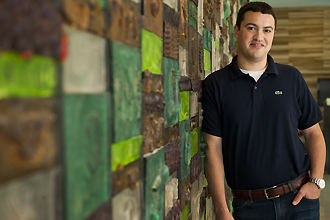Biomed engineer invents easier IUD insertion device
As a foolproof method of birth control, intrauterine devices are unsurpassed. In fact, IUDs are 20 times more effective than oral contraceptive pills, according to a study in the New England Journal of Medicine. However, there's a catch: IUDs are difficult to put in and the procedure can lead to complications. But Tulane University alumnus Ben Cappiello has invented a solution to the problem.

Biotech inventor Ben Cappiello foresees a global market for his new intrauterine device for birth control. Cappiello's headquarters are in the New Orleans BioInnovation Center, a technology business incubator for bioscience entrepreneurship. (Photo by Paula Burch-Celentano)
While still in school, Cappiello, a Tulane biomedical engineering major, designed a device that makes it easier to insert an IUD. After graduating in 2010, he co-founded Bioceptive, a company that is developing and testing the insertion device before marketing it around the world.
In May, Bioceptive, headquartered in the New Orleans BioInnovation Center, announced that it had raised $385,000 in startup money from investors, including Tamara Kreinin, former executive director of women and population with the United Nations Foundation in Washington, D.C.
The current IUD insertion procedure requires a skilled healthcare practitioner, usually a specialist in obstetrics and gynecology, and employs up to five surgical instruments. Because of the multistep nature of the procedure, the IUD can end up being expelled or the uterus can be perforated, says Cappiello. Also, patients often experience pain during the insertion.
The device that Cappiello has invented allows for a gentler IUD insertion procedure. The Bioceptive device has an automatic sensing mechanism that replaces the current surgical tool used in measuring the depth of the uterus, while also incorporating a force-limiting mechanism. “It's impossible to perforate a uterus with this device,” says Cappiello.
Cappiello and his Bioceptive associates, including co-founder S. K. Khurana and Stewart Davis, see a market for the device both in industrialized countries as well as developing nations.
“We want to make this so easy to do that any healthcare worker anywhere in the world can put in an IUD,” he says.
